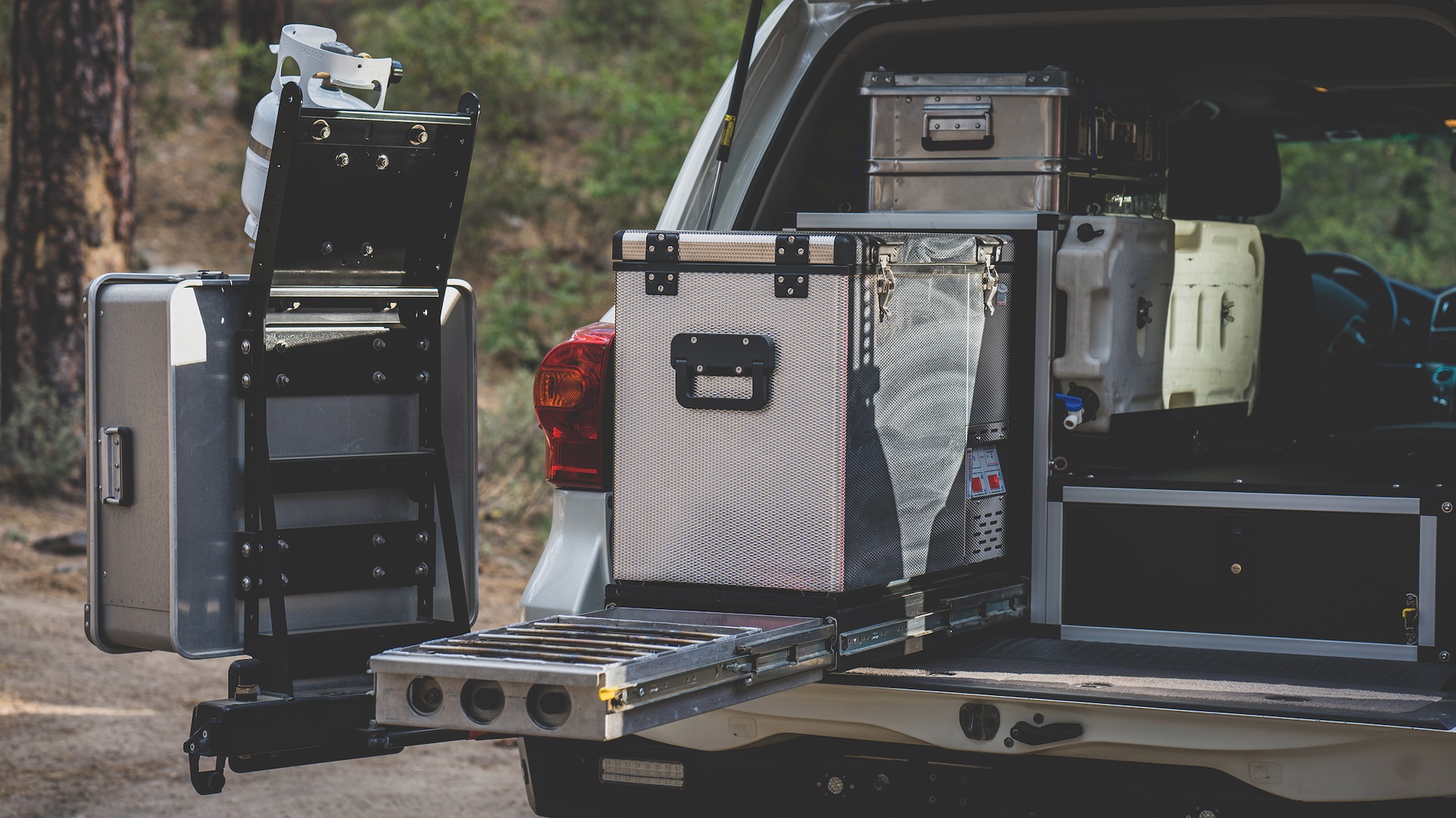Editors Note: This article originally ran in the print version of Overland Journal, Winter 2021 Issue Coolest of the Cool | Testing the latest fridge-freezers to their limits.
Having interviewed hundreds of overlanders, we often ask what their favorite piece of kit is, and almost sheepishly, many reply “my fridge.” The reasons vary, like making ice for margaritas, keeping ice cream frozen for the kids, or preserving that fillet of wild Atlantic salmon for a BBQ in the Maze District. Regardless of why, the 12-volt fridge is a much-loved accessory for the vehicle-based traveler.
Each overlander is different, some eschewing nearly all comforts, crossing continents on a motorcycle with the most minimal of equipment, and there are four-wheeled counterparts that bring everything, including the Nespresso coffee maker. Both have their merits, but few luxuries match the fridge for pure homeyness, improving culinary outcomes paired with a breathtaking view. I have found that a fridge stocked with food and drinks makes the campsite feel like a home away from home, allowing me to cook healthy, plentiful portions for my travel companions, and prepare the proper sundowner for the end of a dusty day.
CONSIDERATIONS
While fridges have become more technology-heavy in recent years, Bluetooth, remotes, and USB ports have little benefit for their intended use, and should be considered a secondary influence on the decision set. Primary attributes are matching the size in liters to the number of travelers (or the days remote), and pairing the insulation and compressor efficiency to the available battery/solar capacity.
Selecting the correct-sized fridge is the most important decision, as travelers often purchase too large of a model that unnecessarily robs the vehicle of interior volume. A solo traveler can easily use a 25- to 35-liter unit, and a couple with children can manage with only a 50-liter. The trick is to avoid refrigerating items that do not need cooling (like eggs, most cheese, and a surprising number of fruits and vegetables), and to only cool drinks needed for the day. A smaller fridge takes up less space, costs less to purchase, and typically uses less amps to run. Fridges larger than 60 liters are challenging to integrate in most vehicle layouts, and are best reserved for large 4WDs, trailers, or campers. As this test focuses on newer models to market, we do evaluate a wide range of sizes.
Another important decision point is the efficiency of the motor and the insulation. While tests like these will often praise higher performance units, those successes come at a cost in both purchase price and overall volume efficiency. If the traveler tends to move each day, then efficiency is far less important. High insulative values require thicker, more expensive injected foam, which requires more labor to assemble, and the walls of the fridge will be thicker. Which in turn either makes the unit larger for the same interior volume, or costs interior volume for the same exterior dimensions. We suggest not buying performance you don’t need.
Notes: We gathered power data via an inline PowerWerx meter and a Bluetooth-enabled Fluke clamp meter. The Fluke generated both graphical and CSV data logs. Heat output is an important consideration for both mounting and venting when the fridge is installed in the vehicle. Dual temperature data loggers were used to ensure accuracy and redundancy during the tests. These units are accurate enough for medical use and are certified for that purpose.
Primary attributes when selecting a fridge are matching the size in liters to the number of travelers (or the days remote), and pairing the insulation and compressor efficiency to the available battery/ solar capacity.
Through our travels, we have found a few things worth investing in, including a cabinet temperature gauge, a low-voltage cutoff, and a freezer unit. The temp readout puts the user at ease, and helps prevent spoilage or frozen radicchio; fortunately, all of the units in this test have some form of gauge. A low-voltage shutoff preserves starting power in the battery and also helps prevent battery damage. The right low-voltage cutoff can even reduce the need for a dual battery in some configurations. However, there are units like the Engel that will run all the way down to 9 volts, which can permanently damage expensive house batteries. It is best to find a fridge with an adjustable cutoff, which lets the user adjust the shutoff point to the system configuration. For example, I run a much higher shutoff voltage when the fridge is running on the starting battery. Lastly, we prefer a unit that includes a freezer compartment, for the simple reason that a freezer makes ice, which will support additional food in a cooler, or cool warm drinks that do not need to take up space in the fridge. Meat can keep for months in the freezer, and there is just something special about unwrapping an ice cream treat in the Gobi Desert.
TESTING
Our evaluation relied on good system design, repeatability, environmental controls, and vigilant oversight. The objective data was collected by our Operations Manager Garrett Mead, who coordinated with me on the testing methods and controls. Each test started with a digital scale weight before moving on to determining start-up amperage, cooldown amp hours and effectiveness (time to 46°F), steady-state amp hours (maintaining 46°F), and time to warm up (to 56°F).
To measure start-up and running amps (which allows for amp hour calculations), we captured the current with a Fluke data logger paired to Garrett’s iPhone. This permits exporting the data as a comma-separated values file (CSV). The data was validated with interval readings from our PowerWerx inline power analyzer. For temperature measurements, we purchased two identical certified data loggers with +/- .6°F accuracy. Both loggers ran during each test to ensure accuracy and to identify possible logging errors. These data loggers export to CSV for analysis and charting. Interestingly, obtaining these units proved quite challenging during Covid as they are used for vaccine storage monitoring. For a fluid thermal load of 423 ounces, we used 38 cans of S.Pellegrino flavored water, arranged without touching the interior sides, placing the temperature sensor probes deep within the center of the load (but not touching the cans) to ensure that the thermal mass achieved our benchmark temp of 46°F.

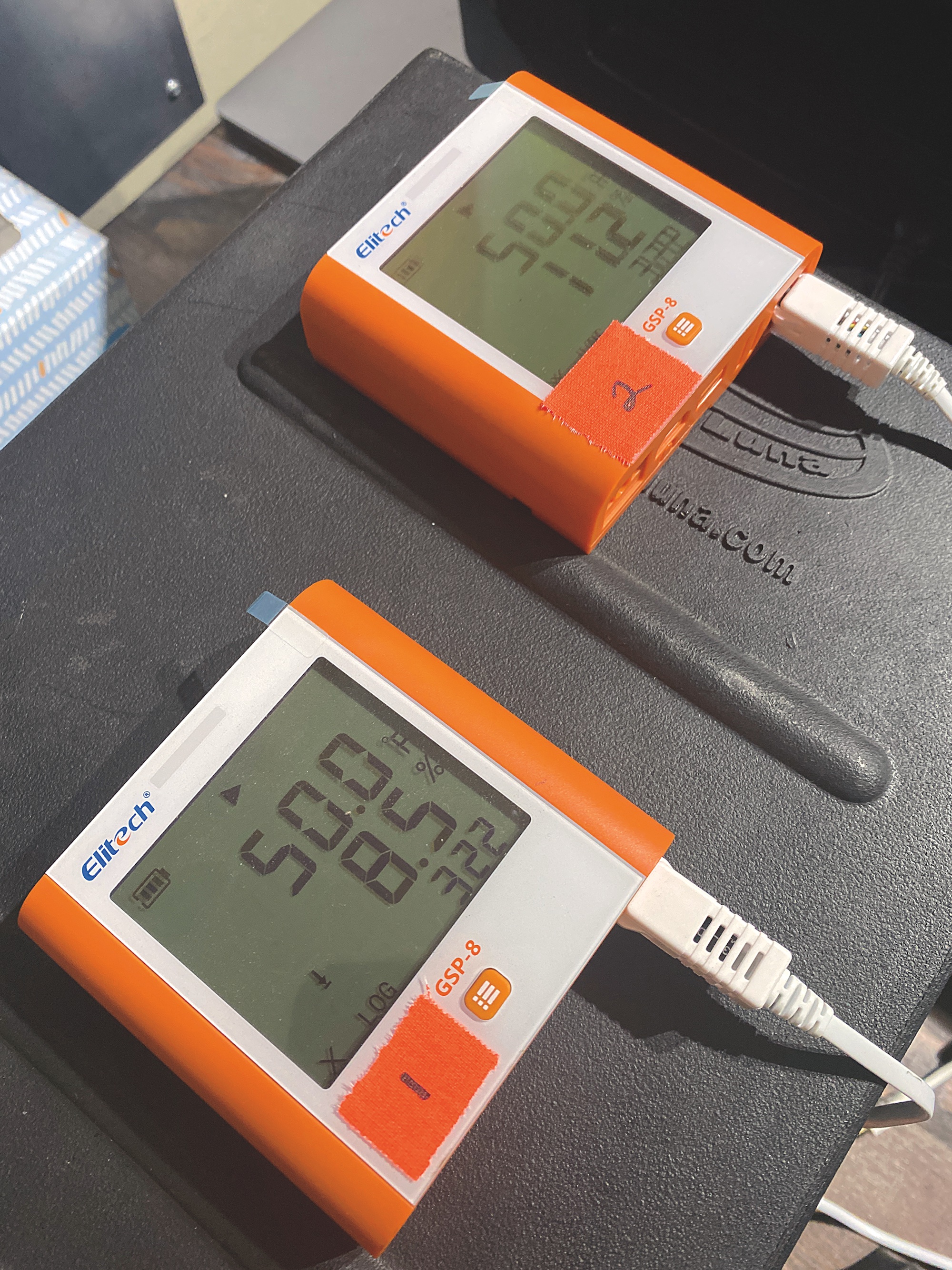
Additional tests included a decibel measurement of the compressor during peak cooling to determine fan, vibration, and other sounds that contribute to a noisy sleeping environment. We also took four cooling vent temp checks with a thermal IR gauge to determine how hot the units ran (to help the buyer consider required cooling spacing and airflow), and we captured Forward Looking InfraRed (FLIR) thermal images of the fridges to look for concentrated heat zones and potential cooling loss areas (for example, around the lid).


Subjective tests included lifting, moving, mounting, loading, and lashing the units, and using them in the field. Considerable insight only comes with adequate use, so all of these fridges have been used on long trips to expose design benefits or flaws. These subjective observations are reflected in the individual reviews and contribute to the final rankings.





ARB | ZERO 73-QUART DUAL ZONE
69 LITERS, 68 POUNDS
ARB has become legendary in the overland market, providing quality components for a wide range of vehicles and a laundry list of accessories. This brings several benefits to a product like fridges, including a global distribution network and economies of scale, driving down costs while improving service and support. When it comes to 12-volt coolers, ARB has regularly outsourced their production, starting with rebranded Engels, then in-house-designed units produced by Dometic. More recently, they have sourced the Zero line from Asia, with an emphasis on the durability of the packaging (i.e., impacts and vibration) and their on-unit and app interfaces.
The Zero’s size is further enhanced by the thickness of the insulation and plastic case, mass of the handles, and sturdy corner guards. It all feels robust in a genuine way, and at nearly 70 pounds, could almost use two people to carry it. All of this mass and volume results in it being the fridge for large families or larger vehicles. It is roughly twice the size of the Engel in overall dimensions, which results in a huge freezer zone and a fridge-side that swallows whole gallons of milk. It is also possible to remove the freezer divider and improve space efficiency even more. Another advantageous feature is the basin drain, which makes cleanup so much easier. This model has the best lashing solution of the test, with stamped stainless steel clip-in brackets and four heavy-duty integrated tie-downs to keep it in place. The phone app is useful and lets you keep tabs on the contents from your beach chair. A few other items I like are the reversing lid and the brilliant idea of putting the 12-volt input on both sides of the case. Accessories are numerous, including mounting kits, wiring kits, covers, and slides.
In use, the weight and size of the ARB are immediately noticeable and will require the right application to fit properly. The performance of the fridge is below average, with faster cooling initially, followed by slower performance as the temperature closes in on the benchmark of 46°F. Interestingly, the resolution of the data logger showed a less than optimal cooling profile, with the controller idling the compressor for short periods despite it being set to maximize cooling. The warm-up was also below average, with the ARB warming 10° faster than any other unit in the test (albeit similar to the Truma as expected). The volume of the fridge is a serious benefit; and the larger volume, when compared with others in the test, will have an impact on cooling and warming efficiencies.
$1,526 | ARBUSA.COM
PROS
Serious volume for large parties
Durable construction
12-volt inputs on both fridge sides
CONS
Less space-efficient than others in the test
Heavy
Below-average performance
CONS
Less space-efficient than others in the test
Heavy
Below-average performance


Left to Right: The Zero is a seriously robust unit, armored for impacts and abrasion. The insulated freezer divider can be removed to create a massive fridge cavity. The ARB has the best tie-down solution of the test, with heavy-duty stainless steel brackets.
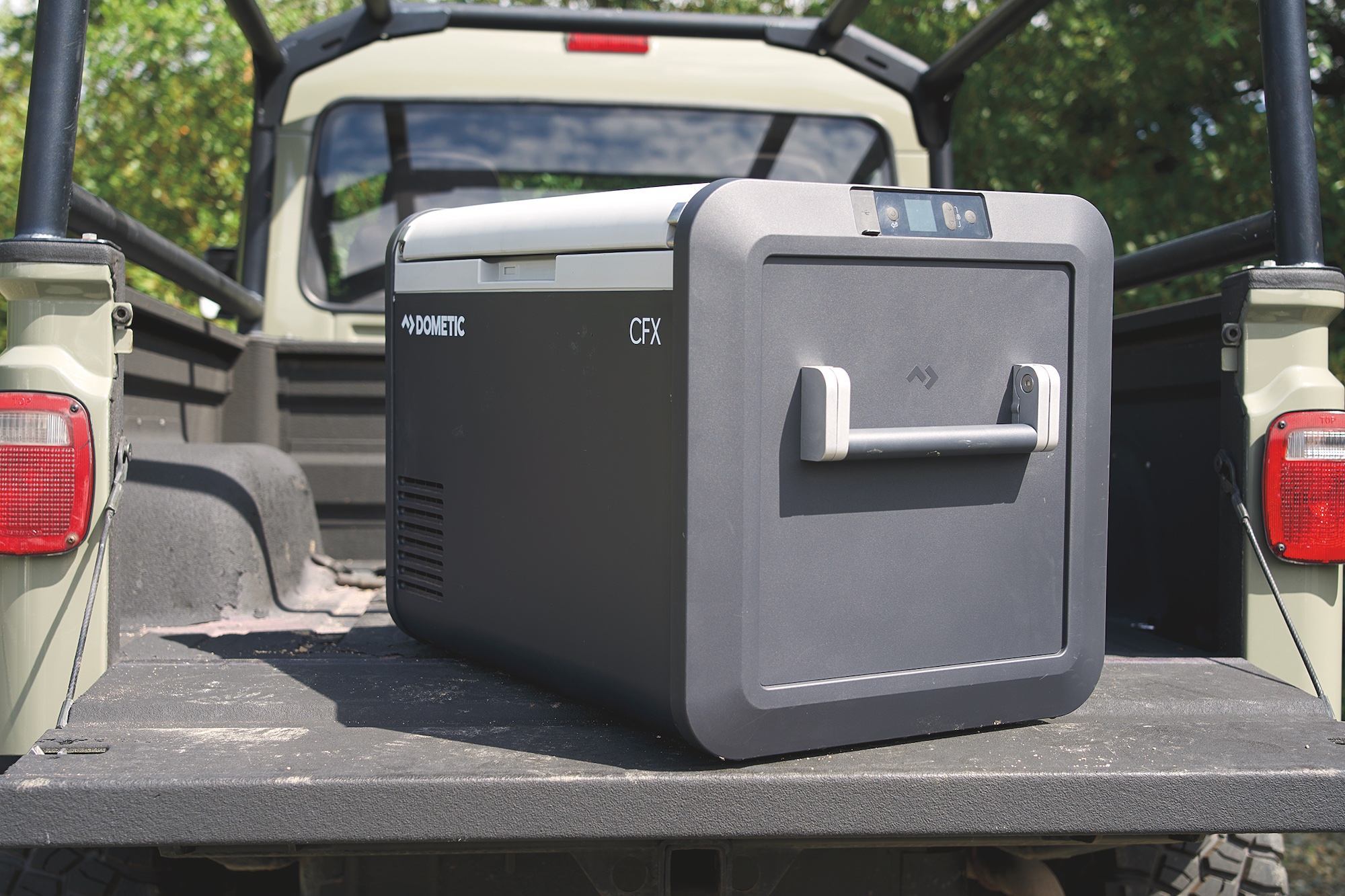
DOMETIC | CFX3 55IM (EDITOR’S CHOICE AWARD)
55 LITERS, 47 POUNDS
Dometic is a powerhouse of the RV, marine, and overland markets, generating everything from stoves to mobile air conditioners. They have also been producing chest, drawer, and upright fridges for decades, and it shows in the level of refinement and features. We have watched the Dometic units evolve, and the current incarnation presents their most travel-friendly model yet, with rounded and reinforced corners, a waterproof LCD user interface packed with information, and one of the best Bluetooth apps in the test.
The CFX looks like a fridge designed for the 2020s, with a modern soft-touch matte finish, sculpted corners, and smooth lid integration. The handles are all that protrude, and lack sharp edges to cut or mar vehicle surfaces. They are also the primary lashing point, and are more than up to the task. When picking up the fridge, it is clearly different, being the lightest in the test, despite average interior volume. This is primarily due to the extensive use of reinforced plastics, but that technology has proven to provide several benefits, including insulation. The downside is scratches and scuffs in the plastic, something the stainless units never show.
The Dometic provides the most useful app in the test, including amp hour usage by hour, day, or week. We noticed that the graph does not have enough upper limit range, with the unit using above the 5 amp hours shown on the app graph. Despite this, the daily graph is helpful for gauging power consumption. It is possible to change the set temperature in the fridge from the app and see the current temperature, both of which are convenient to the passenger while driving—no more spoiled or frozen food. The last feature of note is the lack of a true freezer, but the ability to make ice. For many travelers, the layout is perfect, providing more fridge space, as well as evening libations on the rocks.
For performance, the Dometic gave an impressive result, with the fastest cooling rate of the test. In fact, the effectiveness was so notable, that we tested the unit multiple times to validate the results. Power consumption was also modest at 4.6 amp hours under rapid cooling, owing to the design of their compressor and condenser/evaporator capacity. Dometic did not skimp on insulation either, having the second-slowest warm-up rate in the evaluation, keeping the drinks cooler for longer than all but the National Luna.
$1,099 | DOMETIC.COM
PROS
Best display (and location) in the test
Best overall performance
Lowest weight in the test
CONS
Lack of traditional freezer (which might be a pro for some)
Plastic case and lid will be less durable against scratches


Left to Right: The CFX is minimalist in design, which hides a powerhouse of performance. The main fridge cavity is one of the highest volumes of the test but only allows for freezing ice in the supplied trays. The Dometic display is easy to read and conveniently located on the top side of the unit. It provides intuitive menu control of multiple features.

ENGEL | MT45F-U1CD-P COMBI (VALUE AWARD)
43 LITERS, 55 POUNDS
The first 12-volt fridge I encountered was owned by my neighbor, an old Engel that had served as his garage beer fridge for more decades than he knew. He had only turned it off once—when he moved just down the street from me. I acquired it and used that fridge for years before selling it to a friend. The fridge is still running in their garage, filled with drinks. There is one critical thing to know about an Engel, and that is the swing motor technology. The Sawafuji compressor has only one moving part, the piston, which slides back and forth inside the cylinder, self-lubricating as it runs. The other benefit of this technology is the industry’s lowest start-up amperage (by more than half in some cases), which allows the Engel to be plugged into OEM 12-volt sockets (which have small-diameter wire).
Upon initial review, the Engel’s modest appearance belies its strengths, with a stamped, powder-coated steel shell and molded plastic interior. The unit is notably compact for the volume, lacking anything non-essential (no bulky bumpers or bottle openers, etc.) The handles, from our experience, are only suitable for carrying the unit, not proper lashing. For that, there are robust brackets (sold separately) that affix to the factory captive inserts. This new-model Engel features significantly more detail on its display, including the temperature of the cabinet, the set temp, and the battery state. Another notable feature is an adjustable low-voltage disconnect, which is a first for the brand. The cooling function is simple and robust, with the fridge zone factory set to 0-5°C, and the freezer adjustable from -18°C to +10°C. The size of the fridge can be adjusted to three different volumes, including fridge only.
The performance of the Engel is toward the middle of the pack but should not be considered slow. The data logger showed how steady and consistent the cooling rate was, complemented by the lowest power consumption in the test. On the warm-up, the Engel beat out the ARB and Truma for a mid-pack finish. The strength of the Engel is its reliability and efficiency, including the low start-up amperage and average running draw. Engel addressed many of the upgrade desires we have expressed through the years, including more precise temperature control and an adjustable low-voltage disconnect. The release of a combination fridge-freezer is a win for Engel lovers, although the cooling plate/coil configuration undoubtedly impacted the cooldown times for the thermal load we selected.
$1,099 | ENGELCOOLERS.COM


Left to Right: The Engel is the most compact unit in the test, which will be a benefit for some. As the first Engel fridge-freezer combo, it uses a simple insulating design. While still very analog, this model is the most advanced of any Engel model. We see that as an advantage for many users.
PROS
Lowest start-up amperage
Lowest amp hour draw in the test
Most space-efficient for volume
CONS
Coil configuration is less effective when used as a fridge
Handles not robust enough for rough terrain lashing
Average cooling and warming performance
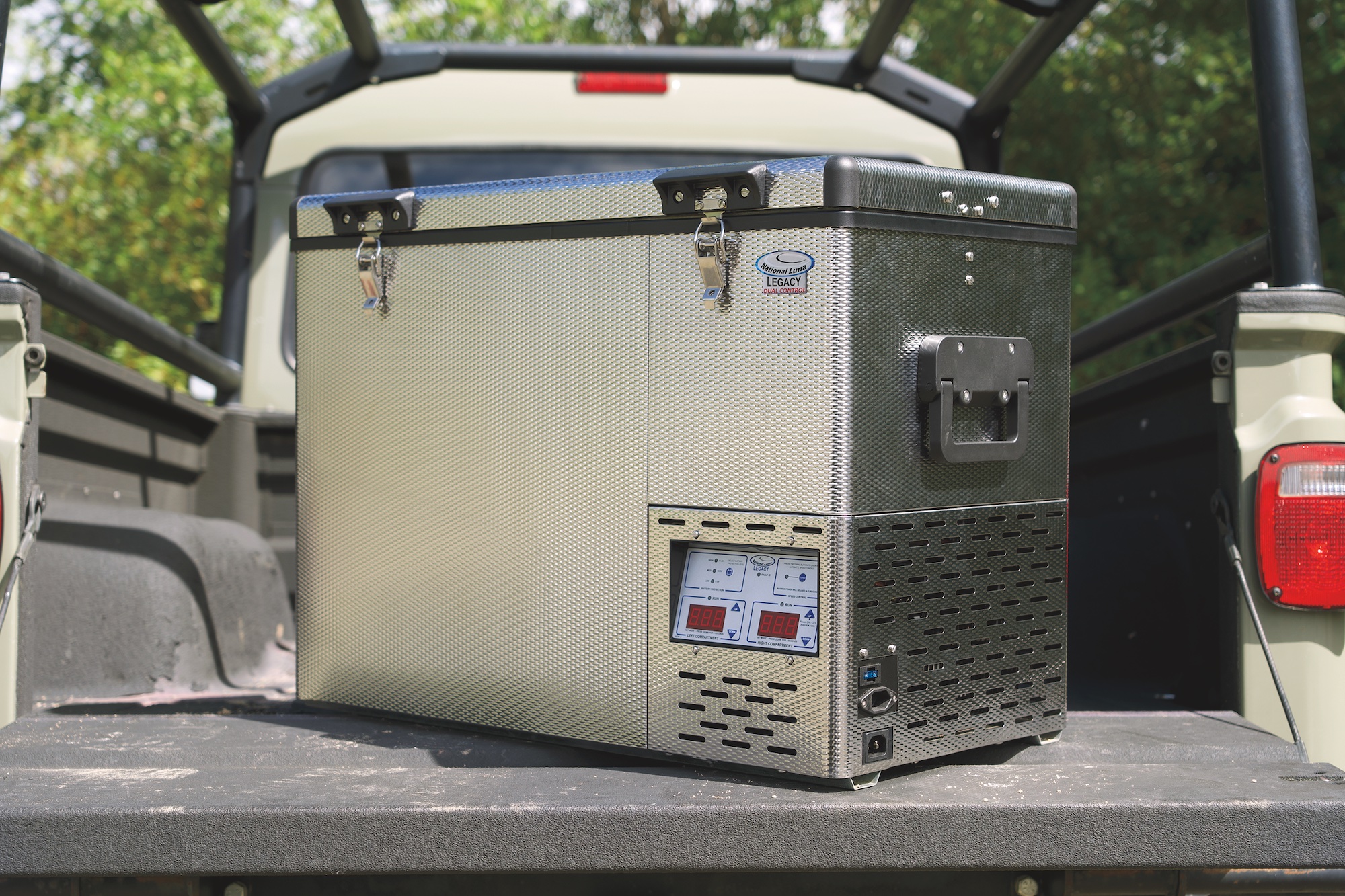
NATIONAL LUNA | LEGACY 50L DUAL ZONE
50 LITERS, 55 POUNDS
The South Africans have been overlanding for a long time and en masse, which resulted in some of the earliest and most notable market innovations for the vehicle-based traveler. This includes the ZA manufactured National Luna fridges, which
have been made in Africa for over 30 years, and won the previous two Overland Journal fridge-freezer tests. They have a wide range of options to suit the needs of the traveler, including models with over 70-millimeter-thick walls filled with premium injected insulation. More recently, they introduced a new Legacy line of fridges that found the optimal confluence of performance, material quality, and value.
The Legacy line incorporates a proprietary “off-road” compressor (still similar to the Danfoss-style) and several improvements in useability, like a fully selectable temperature range for both compartments. This is clever, as the buyer may choose to have a large freezer, and a small fridge, or vice versa. The display is easy to read but can be bright in a sleeping area. The control panel
allows easy adjustment to the three position low voltage cutoff and activation of the turbo mode. It is important to note that this fridge in turbo mode will pull significant power (upward of 7.2 amps), so wiring should be sized accordingly. The fridge is genuinely handsome and classically styled with a dimpled 430-grade stainless steel shell and three-way configurable lid. The handles are robust and fold tight against the body and thoughtfully include a channel to run a strap for lashing. The interior is assembled from aluminum panels and is cooled with copper piping (all contributing to fewer cold or hot spots, an attribute we validated with the FLIR).
The performance of the Legacy compressor is notably different from National Luna units in the past. Despite bottoming the set temperature and selecting turbo mode, the cooling profile would not keep the system at a steady rate. This may be to maximize efficiency (this unit did have one of the lowest amp-hour draws) or to protect the compressor, but it did slow the rapid cooling rate when compared with their past units. Warm-up, however, was right in alignment with the past products, keeping food colder than any of the other models in the test. The thermal load took over 18 hours to warm up 10° in our test environment of a controlled 78°F. The Legacy benefits significantly from the precise and independent control of the two storage chambers. The National Luna switching system actively cools the larger or smaller compartment depending on the user’s needs, which can even change during a trip, like starting with a larger freezer and then shifting to a larger fridge as the trip progresses.
$1,295 | NATIONALLUNA.COM, EQUIPT1.COM
PROS
High quality and attractive materials throughout
Lid can be mounted in multiple directions
Precise, independent compartment controls
Class-leading insulation performance
CONS
Slower to cool than previous models
Two latches to access chest
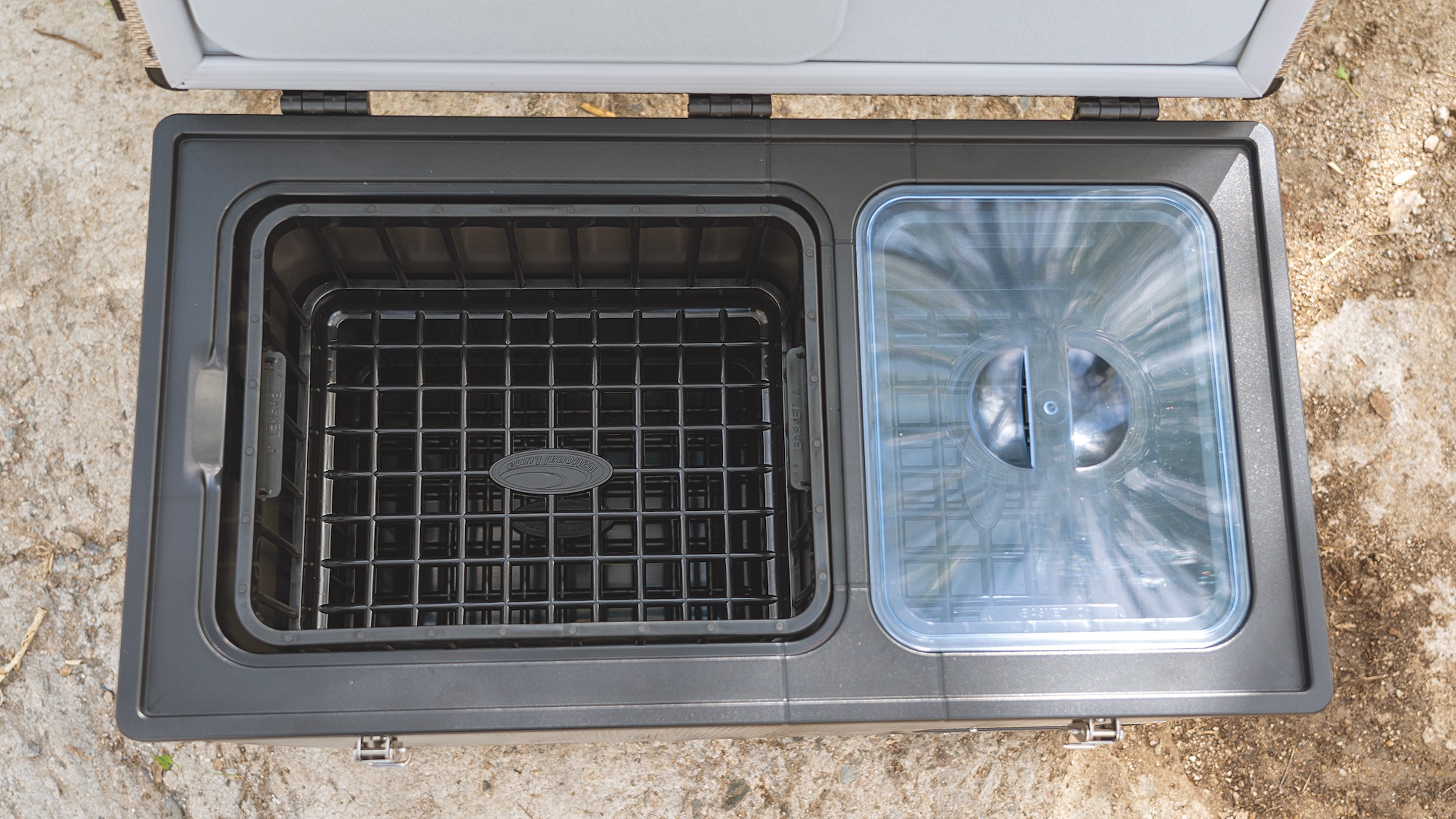

Left to Right: The National Luna is arguably the most classic and attract of all available fridges, with a dimpled stainless steel case and quality materials throughout. The layout is a traditional combi layout, with a large fridge and smaller freezer with a lid. To ensure a good seal the legacy uses two lid latches.
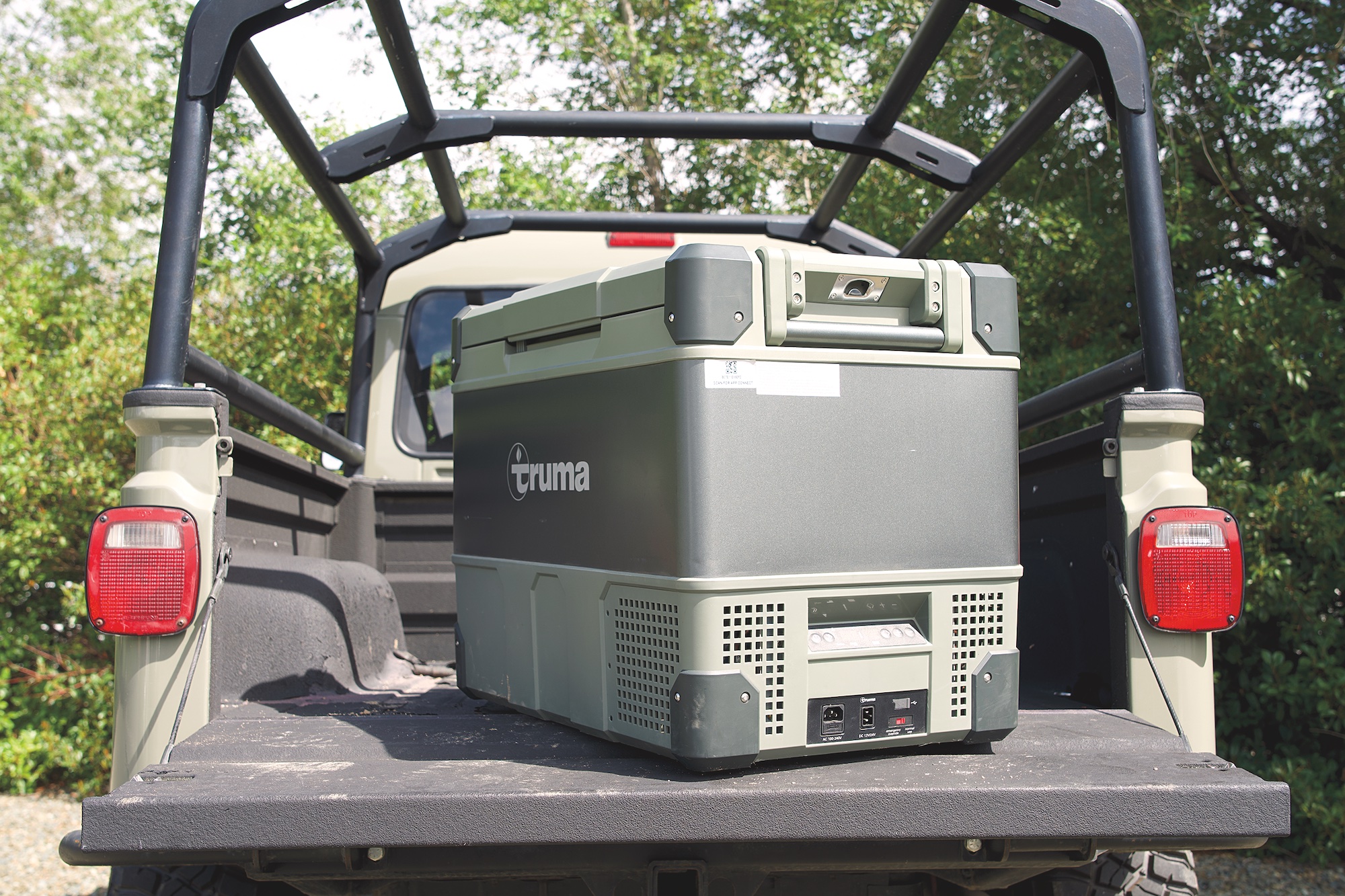
TRUMA | COOLER C69 DUAL ZONE
69 LITERS, 69 POUNDS
Truma appears to be new to the market, but they are one of the oldest companies in the test. The business was started in 1949 as part of the Marshall Plan for German economic development after World War II. As a way of honoring US President Harry S. Truman, the founder, Philipp Kreis, called it Truma. The company’s first product was a gas lamp, followed by 70+ years of camping and RV equipment for the European market. In 2013, Truma opened its North American operations, providing hot water heaters, air heaters, combi-units, and more recently, portable refrigerators like the 69-liter unit in this test.
The lineup of Truma fridges is impressive, offering everything from 36 liters to 105 liters. Their adventure line of dual-zone units includes 69- and 96-liter models, so we selected the unit closest to the test size range. Initial inspection reveals robust construction with reinforced rubber corners and handles that fold flat against the sides. Connecting the 12-volt power supply is available on both sides of the fridge, which is a clever solution shared with the ARB. The lid can also be reversed to allow for more placement options. The on-unit display allows for the adjustment of compartment temperatures, along with a turbo mode for rapid cooling. The display shows the current temp or set temp for the individual compartments. Using the smartphone app allows for additional adjustments, including battery voltage at the unit and adjusting the low-voltage cutoff settings.
The Truma fridge is a solid performer, providing the second-fastest cooling time of the test. It just bests the National Luna Legacy, with a similar cooling cycle to the ARB, featuring short waves of slightly faster and then slightly slower cooling intervals. The cooling rate was generally consistent, which speaks to the compressor performance and the support of the fan and overall coil and condenser surface area. The freezer configuration uses a lid and insulation barrier, combined with increased coil density on the freezer side of the chest. Its modular solution allows for less control of the freezer compartment temperature, but it also allows the entire unit to be used solely as a fridge. For the warm-up, the Truma demonstrates a lower insulation effectiveness than all other units, with the exception of the ARB (which performed similarly). It is difficult to assess the type of insulation used without destroying the test unit, but it warmed the contents almost 40 percent faster than the supremely well-insulated National Luna. The Truma benefits from a robust, stylish case and a feature-rich display and app control. This unit is a great choice for travelers with more vehicle space and the desire for a larger fridge volume.
$1,549 | TRUMA.NET


Left to Right: The Truma is a combination of high-strength plastic and a metal side band. The handles are notable in how they fold into the sides of the fridge. The traditional layout of a combination fridge is useful, and the freezer divider can be removed. The Truma has a comprehensive display and power options, including two 12-volt inputs.
PROS
Robust, reinforced plastic
12-volt inputs on both ends
Dual control over the 69-liter volume
CONS
Lower space-efficiency with bulky walls and rubber corners
Average insulation performance, despite wall thickness
Heavy

CONCLUSIONS
This is Overland Journal’s third comprehensive fridge test, the first completed nearly 13 years ago. In the previous two tests, the National Luna was the standout performer, showcasing the company’s near solitary focus on vehicle-based fridge-freezers. A lot has changed in the subsequent decade, with fridges becoming extremely popular, even in the general consumer space, allowing for significant investment in technology, design, and manufacturing. All of the fridges are improved, and the gap closed around our reigning champ. There are now solutions for every buyer.
VALUE AWARD
For the Value Award, it comes down to the Engel Combi and the Dometic CFX3. They are both priced at $1,099, and are outstanding performers in their own right. Beyond that, each unit is quite different in the benefits they provide.
The Engel is the most space efficient (exterior versus interior volume) and the most power efficient in the test. I especially like the classic and simplified metal case and easy-to-remove lid. Having used Engels for over two decades, their reliability cannot be understated. The Dometic packs class-leading overall performance, along with light weight and the best display of the test. It is worth noting that the National Luna is a great value too, with premium materials and class-leading insulation, albeit at a higher price. Objectively, they are all exceptional values, but the Engel epitomizes the spirit of value and minimalism, requiring less power (start-up and running amps), less space, and a modest purchase price. It also benefits from one of the most important value predictors of all—reliability.
EDITOR’S CHOICE AWARD
For this test, the Editor’s Choice was a surprise, the result only possible because of the resolution, diversity, and controls of the testing process. We have found it important to have repeatability in the testing model, at least as much as possible within reasonable constraints. This effort demonstrated how good fridges have become, as well as the strengths and weaknesses of each model. While all of the subjective and objective criteria are important, there are a few criteria that matter on nearly every day of an overland journey, like unit weight (which impacts payload), cooling efficiency, insulation, and average amperage draw. There are also more subjective considerations, like ease of use, interior layout, and straightforward cleaning. All of these elements culminated with the Dometic and National Luna vying for our Editor’s Choice.
In past tests, the National Luna has dominated both cooldown and warm-up results, a combination of both insulation and coil construction/density. For the first time, a National Luna model was bested in cooldown performance, the Dometic cooling rapidly and smoothly down to our benchmark 46°F. The Dometic cooled down nearly twice as fast as the slowest unit in the test, and did so with an average of 4.6 amp hours. On the insulation test, the National Luna was better, resulting in the best-in-class warm-up performance. However, the Dometic was the second-best warm-up result. From here, the Dometic won out on usability, having an excellent app, the lightest weight in the test, a high-mounted display (which I prefer), and efficient power usage. While I have also personally used National Luna fridges for almost two decades, I have selected the Dometic CFX as my Editor’s Choice because of its near optimal execution of the functions most needed in a 12-volt fridge-freezer.



DISCLOSURES
Even our best attempts to control variables and ensure repeatability of our tests results in a degree of falsifiability. Disclosures surround the function of how fridges determine their case temperatures, and any competitive advantage around compartment design.
As a control, we set each fridge to their lowest possible set point, and then monitor the temperature of the thermal load by the display on the data logger. The load cools much more slowly than the walls of the fridge, and thereby the fridge’s temperature probe. While most fridge controllers compensate for this effect, it is possible for unusual cooling profiles to present themselves as the fridge is tricked by its own probe data or controller logic. Update: National Luna advised that the system independently cools both compartments, which resulted in the profile shown on the cooldown chart. Cooling over 400 ounces of liquid from room temperature to 46°F is a particularly challenging expectation of a fridge.
Each of these fridges have a freezer capability, but the Dometic only freezes ice in two small trays. As a result, the Dometic has some design advantages toward rapid cooling of a single compartment. We tested the Dometic by also including room temperature ice trays, effectively increasing the total fluid it needed to freeze. Despite this, it still performed faster than others in the test, and the slower of the test results are reflected in the chart. The opposite is true for the Engel, which uses a unique coil plate design, which allows for a combination fridge-freezer. This design is less efficient at cooling fluids quickly, but was still tested in accordance with the unit’s published use case as a fridge or a freezer.
We intentionally selected newer models that incorporate a freezer function and brands that are known for reliability, which does eliminate some brands.


